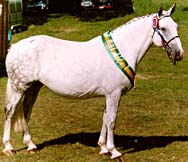Irish Draught
N/A
Fri, 15th November, 2024 - 8:22 am GMT
Sponsor Ads:

Alternative Name
N/ABasic Info
The Irish Draught Horse is an active short-legged powerful horse with substance and quality. It is neither as massive nor as heavily feathered as its name implies. It is proud of bearing, deep of girth and strong of back and quarters. Standing over a lot of ground it has exceptionally strong and sound constitution. The Irish Draught's movement is smooth and free but without exaggeration and not heavy or ponderous. They may be of any strong whole color, including grey. White legs, above the knees or hocks are not desirable. Their bones should be good and strong. Stallions average size is approximately 15.3 hands to 16.3 hands. Mares average size is 15.1 approximately hands to 16.1 hands.
Health
N/AHabitat
N/ABehavior
It has an intelligent and gentle nature and is noted for its docility and sense. Good strong bone.Origin
EuropeHistory
The Irish Draught's history lies as much in battle as it does in agriculture. Written in 1 BC, the "Cuchulain Saga" describes mighty chariot horses of Irish Draught type. In the twelfth century came the arrival, in Ireland, of the Anglo-Normans with their strong war horses. Later, in the sixteenth century, trade between southern Ireland and Spain brought a strong mix of Spanish blood to the native horses. The Irish Draught has been exported in huge numbers into the armies of Europe since the Middle Ages. As recently as the first World War the Irish Draught served on the front lines in the thousands. The hundred years from 1850 to 1950 probably did the most to shape the Irish Draught as we know it today. Agriculture in Ireland was mixed, with less demand for the heavy draft breeds popular in the rest of Europe. Instead, the Irish farmer needed a horse that could work the land but would also pull the dog cart to church at a smart trot and take the farmer fox hunting. The hunting farmer wanted a horse that would go all day and jump anything he faced. Over a century of selection produced a very sound, sensible animal with good bone and substance, great stamina and an uncanny jumping ability. It is these qualities that, when crossed with the Thoroughbred, produced the world renowned Irish Hunter. This cross is now known as the Irish Sport Horse, and representatives are winning gold medals and grand prix all over the world. Unfortunately, this success as a foundation breed nearly led to the Irish Draught’s downfall. The decrease in farm mechanization and the worldwide demand for hunters and sport horses brought the breed to the brink of extinction. It was more profitable for the Irish farmer to supplement his living by breeding his good draught mare to a thoroughbred than to breed her to a purebred stallion. Even with the concerted efforts of the Irish Draught Horse Society, founded in 1976, the breed is considered endangered with barely 2,000 purebreds worldwide.Common Foods
grassSponsor Ads:
"Appear at points which the enemy must hasten to defend; march swiftly to places where you are not expected." -- Sun Tzu, The Art of War
Irish Draught
Coded by: BGID® | ALL RIGHTS RESERVED Copyright © 2000-2024
Disclaimer | Privacy | Report Errors / Contact | Credits









 Beware the new Naval power, they are planning to come on stream with big naval might to match their ground forces. Chinese Aircraft Carrier - Chinese Navy
Beware the new Naval power, they are planning to come on stream with big naval might to match their ground forces. Chinese Aircraft Carrier - Chinese Navy  versus
versus 
 versus
versus  This Thread is about the North Korean Military itself - the kind of army, navy, and air force they have.
This Thread is about the North Korean Military itself - the kind of army, navy, and air force they have. 
 versus
versus  versus
versus 
 versus
versus  versus
versus